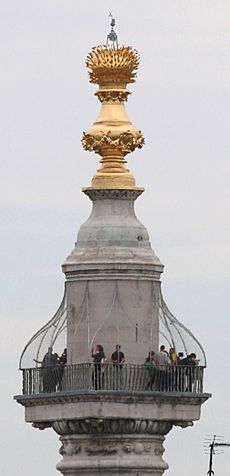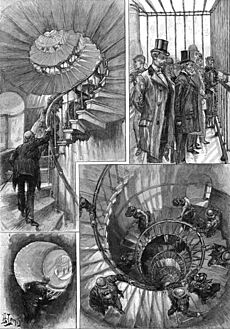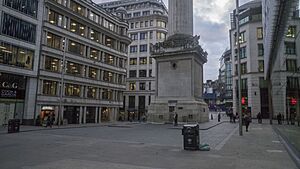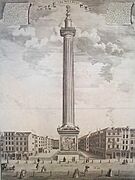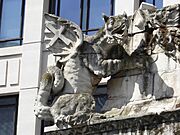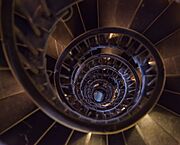Monument to the Great Fire of London facts for kids
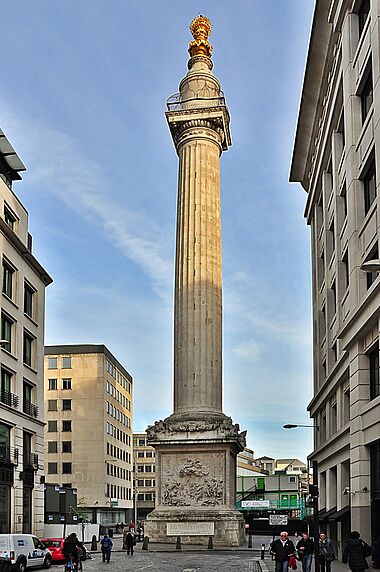
The Monument to the Great Fire of London, often called simply the Monument, is a tall stone column in London, England. It stands near the northern end of London Bridge. This monument remembers the terrible Great Fire of London. It is exactly 202 feet tall and 202 feet west of where the Great Fire started on September 2, 1666, in a place called Pudding Lane.
The Monument was built between 1671 and 1677. It stands where the first church destroyed by the fire, St Margaret, New Fish Street, once was. It's a very important historical building, protected by law. Another monument, the Golden Boy of Pye Corner, shows where the fire finally stopped.
Contents
What the Monument Looks Like
The Monument is a column made of Portland stone. At its very top, there's a golden urn (a large decorative vase) with flames coming out of it. Robert Hooke designed it. Its height of 202 feet matches the distance from where the fire began at the bakery of Thomas Farriner.
Near the top of the Monument, there's a viewing platform. You can reach it by climbing a narrow, winding staircase with 311 steps. In the mid-1800s, a metal cage was added around the platform to keep people safe and prevent them from jumping.
The base of the Monument has inscriptions written in Latin on three sides. The south side talks about what King Charles II did after the fire. The east side explains how the Monument was built and which mayors were in charge. The north side describes how the fire started, how much damage it caused, and how it was finally put out.
For a time, words were added to the east side that wrongly blamed a group of people for starting the fire. This false accusation was later removed in 1830 when laws changed. The west side of the base has a beautiful relief sculpture by Caius Gabriel Cibber. It shows the destruction of London and how the city was rebuilt. You can see King Charles II guiding the rebuilding work, surrounded by figures representing things like Architecture and Justice. The Monument also gives its name to the nearby Monument Underground station.
History of the Monument
After the Great Fire, a law was passed in 1669 saying that a column should be built to remember the terrible event. It was to be placed on Fish Street Hill, near where the fire began. Christopher Wren, a famous architect, was asked to design it. Robert Hooke, who worked with Wren, helped create the design. It's not fully clear how much they worked together, but Hooke's drawings for the column still exist, with Wren's approval on them.
The City Council approved the design in 1671, and it took six years to build the 202-foot column. It took two more years for the inscriptions to be put in place.
Hooke's drawings show different ideas for the Monument's top. Wren first wanted a statue of a phoenix, a mythical bird rising from ashes. Later, he thought about a 15-foot statue of King Charles II or a woman representing London. But in the end, they chose Robert Hooke's idea: a flaming golden-bronze urn.
The total cost to build the Monument was about £13,450.
In 1763, the writer James Boswell visited the Monument. He climbed all 311 steps to the top, which was then the highest viewpoint in London. He felt scared halfway up but kept going. He described it as "horrid to be so monstrous a way up in the air."
In 2006, the area around the Monument's base, called Monument Street, was made into a pedestrian-only zone. The Monument itself closed in July 2007 for a big 18-month renovation project and reopened in February 2009.
In October 2011, a special "Live Music Sculpture" was performed inside the Monument. This was the first time music had ever been played inside the structure, turning Hooke's design into a giant musical instrument.
The Monument as a Science Tool
Wren and Hooke designed the Monument to be more than just a memorial; they also wanted it to be a scientific tool! It has a central shaft that was meant to be used as a zenith telescope (for looking straight up at the sky) and for experiments with gravity and pendulums. There's even an underground laboratory connected to it.
However, the vibrations from heavy traffic on Fish Street Hill made it hard to do accurate experiments. At the very top of the Monument, a lid on the urn covers the opening to this shaft. The steps inside the tower are all exactly 6 inches high, which allowed them to be used for studying air pressure.
In 2020, scientists from Queen Mary University of London used the Monument's stairwell shaft for an experiment. They twisted a wire hanging down the shaft to measure tiny changes in its shape.
Panoramic Camera System
During the renovation from 2007 to 2009, a special 360-degree camera was placed on top of the Monument. This camera takes new pictures every minute, 24 hours a day. It records the weather, building activity, and what's happening in the city below.
Monument Square
The Monument stands in Monument Square. This area used to be called Monument Yard and was later combined with Monument Street. It's located on the east side of Fish Street Hill and reaches to Pudding Lane. A modern glass building, designed by Bere Architects, was opened there in 2007.
The Monument in Stories
The Monument has appeared in many books and films:
- In William Godwin's novel Deloraine (1833), the Monument is mentioned to show a point of no return for the hero.
- It's an important setting in The System of the World, a book by Neal Stephenson.
- In Charlie Fletcher's children's book Stoneheart, the hero George has a fight at the top of the Monument.
- The Monument's viewing platform is shown in the 1970 film The Man Who Haunted Himself, where a character has a secret meeting.
Gallery
- Monument to the Great Fire of London
See also
 In Spanish: Monumento al gran incendio de Londres para niños
In Spanish: Monumento al gran incendio de Londres para niños


